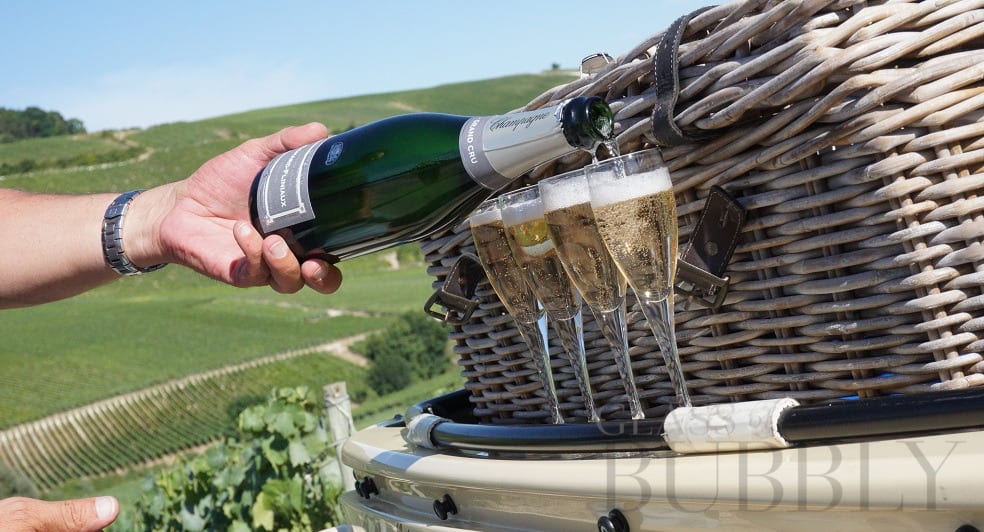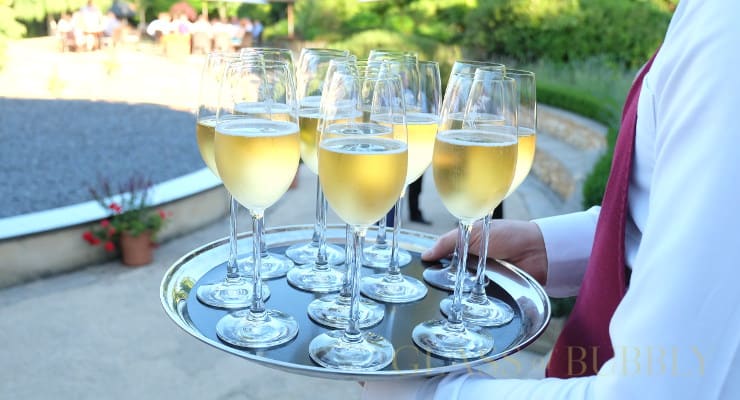The Difference Between Champagne and Sparkling Wine
15th February 2022

It’s your friend’s birthday, you got a great wine cooler sleeve and all you need to do now is put a bottle in. You check out the selection at the local store and you’re overwhelmed. Do you choose Champagne or sparkling wine? What is even the difference? To put it simply, Champagne is sparkling wine, but not all sparkling wine is Champagne. Let’s delve deeper into this.
Champagne refers to a geographical area, not a type of wine
Champagne is a type of sparkling wine that is grown, fermented and bottled in the area called Champagne, a winemaking region in northern France, near Paris. This area has been a winemaking headquarter since the 1700s. Therefore, when we talk about Champagne, we need to think in terms of a geographical location and not to a winemaking style. Champagne is a historic, traditional, established and renowned type of sparkling wine. It’s a name that stands for something that everyone understands and respects. Because of this, many people call any wine with bubbles ‘Champagne’ even though this is wrong. According to European Law, the only legally recognized and allowed, labelled bottles of Champagne, are required to be bottled within 100 miles of the Champagne region of France. This ensures the essence and originality of Champagne sparkling wine and points to any ‘fakes’. Any sparkling wine that is produced outside of the Champagne region but within France, is known as Crémant.
What is the fizz about Champagne?
All sparkling wines made in Champagne are governed by strict regulations of the Appellation d’Origine Controlée (AOC). For starters, Champagne needs to be grown, fermented and bottled in the Champagne area of France to be legally possible to be called Champagne. AOC also dictates how the grapes must be grown to how they must be harvested and processed. These rigorous standards are some of the things that distinguish Champagne. One of the rules is that all grapes in Champagne must be handpicked and they must be pressed only in a covered environment. They may only be pressed twice, once to make the ultra-concentrated cuvée (which is high in sugar and acid) and the second time to make the taille (sugary, lower in acid, and higher in minerals and pigment).
A typical Champagne can only be made from 7 types of grapes: Chardonnay, Pinot Noir, Pinot Meunier, Pinot Blanc, Pinot Gris, Petit Meslier or Arbane grapes. Most commonly, the first three are used.
Champagne is globally recognized for its creaminess and depth, as well as its famously small and persistent bubbles that not many other sparkling wines can boast about.
If you look online at Brianswines.ie or another similar site, you’ll also see a large selection of wines that aren’t sparkling at all but made with the same kind of grapes that are used for Champagne. In this sense, the type of grapes used may be the same, but the type of wine produced is completely different.
Sparkling wines
Unlike Champagne, which is made only in France’s eponymous region, sparkling wines are made globally, using very diverse types of grapes and production methods. There are several types of sparkling wine. Speaking globally, the most recognized sparkling wines are the Prosecco from Italy, Cava from Spain, the sparkling wines of California and of course – Champagne. However, not all sparkling wines are created equal.

Views from L’Antica Quercia Vineyard – Prosecco Region
It’s all about the method
There’s a wide gap between Champagne and other sparkling wines made using the same, traditional method. However, there’s an even wider gap between Champagne and sparkling wines that are not made using the traditional method.
Méthode Champenoise (Traditional Method)
So, what is the traditional method? This labour-intensive process, the méthode traditionnelle/Champenoise, is a very strict set of guidelines developed in France. Two separate rounds of fermentation are used—one in a tank or barrel, and a second in the bottle itself. The in-bottle fermentation is what gives the wine its characteristically fine, persistent bubbles. Unlike different sparkling wines, the second in-bottle fermentation of Champagne is followed by a minimum ageing period of 15 months. This is a very complex process and each bottle is handled carefully many times.
The long, intricate process commences with hand-picked grapes which are then fermented into still wine. Then, the yeast and sugars are added, which starts the second fermentation as it is bottled. Over time, trapped CO2 gas carbonates the liquid to form the trademark bubbles while yeast cells start to die. The wine in the bottle is then aged for at least 15 months with the dead yeast cells (known as ‘on the lees’). The yeasts release roundness and the characteristic aroma and flavour to add texture and complexity. During this time, clarification occurs via a process known as riddling, which rotates the bottle slowly to capture the dead yeast cells at the neck before the yeast is removed through disgorgement, topped off with sugar and wine known as the dosage, then sealed.
Charmant method
The Charmat method, also known as the tank method, is one of the most commonly used methods globally. This process skips the secondary fermentation that takes place in-bottle for 15 months. Instead, it consists of a pre-bottling of the second round of fermentation in a large stainless-steel tank, after which it gets bottled. Therefore, compared to the traditional method, the Charmat method is much faster and less expensive.
It can produce delicious sparkling wines, but they’re often fruitier than Champagne and other sparkling wines made using the traditional method. Their bubbles aren’t as bubbly as in the genuine Champagne. These wines have fewer bubbles, that are coarser and less persistent. Prosecco is the best-recognized sparkling wine from this category.
Méthode Petillante
The cheapest sparkling wines are made using the same method as soft drinks. Essentially, carbon dioxide gets pumped into the giant tank, then gets transferred into a bottle. Nothing fancy about it, but – this method enables fast production of larger amounts of sparkling wine. However, it is of lower quality and is therefore also very cheap.
Sparkling to not so sparkling price
The price varies greatly for sparkling wines. Genuine Champagne alone varies greatly in price with the most expensive one costing thousands of euros. Generally speaking, dry, fine bubbles usually have a higher price range, whereas slightly sweet, citrusy, and coarse ones cost less. The price is determined by three factors: labour, geographical area and number of produced bottles.
Labour of love
If the method requires extensive labour – as it does for the traditional method, and especially more so for Champagne, it costs more. The people involved, the equipment involved, the highest quality of
grapes – it all adds up to create a higher price range. However, the connoisseurs decidedly claim that taste justifies the price.
Geographic area
The land where the grapes grow, hence the geographical area, also plays an important part as only the best soil produced the highest quality of grapes. For one, areas that are sunny with quality soil and other specifical components are the best for that perfect glass of bubbly. Possessing such land and maintaining such land is also an industrious and costly task.
Production numbers matter
Lastly, the number of bottles that were produced dictates the price as well. Essentially, we can also divide this into vintage and non-vintage categories.
Vintage
The vintage category is always the priciest one. And no, it doesn’t refer to old wine or old grapes. Vintage means that the sparkling wine was made using grapes from the same year.
Using only grapes from one year – vintage means that the grapes of that year were of outstanding quality so that dictates the price. This can also be the case if the grapes were scarce in a specific year and the bottles produced were few. Much like with everything, when something is more unique, it is considered higher quality and therefore more expensive.
Non-vintage
Most sparkling wine is non-vintage. Makers take the juice from several different years and blend it together to make the bubbly, to keep a consistent flavour profile from year to year.

Choice of bubbly to mull over
Producers around the world make fine sparkling wines. But each has unique characteristics—flavour, texture, richness and depth, due to each place’s unique soil, climate, and other specific elements that affect the qualities of its wines. Here are some of the globally most recognized types.
Cava
Cava is a Spanish sparkling wine. Like Champagne, Cava is made using the traditional method. Grapes used are usually Macabeu, Parellada and Xarello kinds. Cava is made in different varieties, but the best one is said to have similarities with Champagne – small bubbles and the balanced taste of fresh and creaminess.
Prosecco
Prosecco is made in the Veneto region of Italy. The Prosecco sparkling wine has larger bubbles than Champagne and is produced in large tanks using a method called the Charmat. This popular Italian sparkling wine has large bubbles and a fruity aroma—making it a common choice for mixed drinks like mimosas or bellinis. Prosecco sparkling wine is made with either Prosecco, Glera or Bianchetta Trevigiana grapes. It is most often a dry or off-dry sparkling wine, although its character can make it seem sweeter.
Sekt
Austrian and German sparkling wines are called Sekt. The wines are made using the Charmant method of fermentation in stainless steel. These wines vary in sweetness and dryness and are typically less alcoholic than Champagne.
Crémant
Crémant is a style of sparkling wine produced in France using the traditional method. Crémant often has softer bubbles and a creamier taste.
American
American sparkling wine use many different blends of grapes. There is a large variety of different flavours to be discovered.
How to choose a good sparkler?
Some sparkling wines taste bready, some citrusy, some fruity, it all boils down to your personal preference. Some general guidelines would be that the taste should feel fresh and sparkling. Not necessarily sweet, but with small bubbles that tingle your tongue.
Most often, sparkling wine will be labelled ‘brut’ or ‘extra dry’. Brut tastes dry and has no sweetness. Extra dry, on the other hand, tastes slightly sweet.
When choosing a sparkling wine, first determine what you’d like to get out of it. If it’s quality, a Champagne or higher quality sparkling is an excellent choice. However, if you need a sparkling wine to be mixed into other juices, a less expensive, lower-quality sparkling wine will be suitable.
Don’t let the bubbles fool you the next time you pop that bottle and click glasses. Let’s repeat: all Champagne is sparkling wine, but not all sparkling wine is Champagne.
![]()
Glass of Bubbly Content
Content shared by this account is either news shared free by third parties or advertising content from third parties and affiliations. Please be advised that links to third party websites are not endorsed by Glass of Bubbly Ltd - Please do your own research before committing to any third party business promoted on our website.
